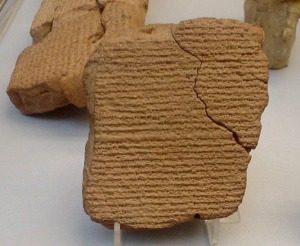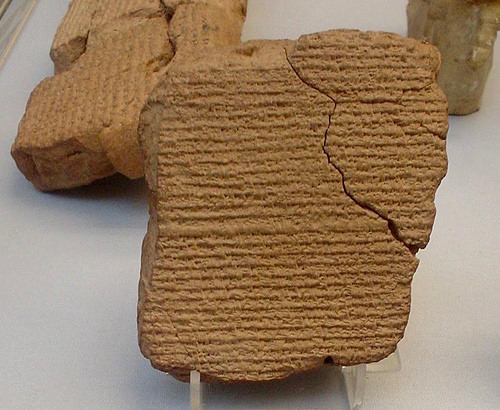
Analysis of ancient Babylonian tablets reveals that, to calculate the position of Jupiter, the tablets’ makers used geometry, a technique scientists previously believed humans had not developed until at least 1,400 years later, in 14th century Europe. These tablets are the earliest known examples of using geometry to calculate positions in time-space and suggest that ancient Babylonian astronomers may have influenced the emergence of such techniques in Western science.
In the report* published in Science, Mathieu Ossendrijver discusses the translation of four almost completely intact tablets that were most likely written in Babylon between 350 and 50 BCE. They depict two intervals from when Jupiter first appears along the horizon, calculating the planet’s position at 60 and 120 days. The texts contain geometrical calculations based on a trapezoid’s area, and its “long” and “short” sides; previously, it was thought that Babylonian astronomers operated exclusively with arithmetical concepts. The ancient astronomers also computed the time when Jupiter covers half of this 60-day distance by partitioning the trapezoid into two smaller ones of equal area.
While ancient Greeks used geometrical figures to describe configurations in physical space, these Babylonian tablets use geometry in an abstract sense to define time and velocity, Ossendrijver notes. These tablets redefine our history books, revealing that European scholars in Oxford and Paris in the 14th century, who were previously credited with developing such calculations, were in fact centuries behind their ancient Babylonian counterparts.
Historically, the origin of Western astronomy has been attributed to Mesopotamia, with later work in the exact sciences evolving from the work of the late Babylonian astronomers. Moreover, the earliest astronomy is thought to have been developed by the Sumerians going as far back as the Early Bronze Age, reflected later in the earliest Babylonian star catalogues dating from about 1200 BCE. Only fragments of Babylonian astronomy have survived, documented on clay tablets with ephemerides and procedure texts. But these surviving fragments show that, according to the historian A. Aaboe, Babylonian astronomy was “the first and highly successful attempt at giving a refined mathematical description of astronomical phenomena” and that “all subsequent varieties of scientific astronomy, in the Hellenistic world, in India, in Islam, and in the West—if not indeed all subsequent endeavour in the exact sciences—depend upon Babylonian astronomy in decisive and fundamental ways.”**
__________________________________________
A Babylonian tablet recording Halley’s comet during an appearance in 164 BC. At the British Museum in London
___________________________________________
This article adapted and edited in part from the subject Science news release.
*”Ancient Babylonian astronomers calculated Jupiter’s position from the area under a time-velocity graph,” by M. Ossendrijver at Excellence Cluster TOPOI in Berlin, Germany; M. Ossendrijver at Humboldt University in Berlin, Germany.
**A. Aaboe (May 2, 1974). “Scientific Astronomy in Antiquity”. Philosophical Transactions of the Royal Society 276 (1257): 21–42.
_________________________________________________________
In addition, the latest Popular Archaeology ebook is now available.
______________________________________________
Travel and learn with Far Horizons.
____________________________________________
This richly illustrated issue includes the following stories: Two remarkable discoveries that are shedding light on human beginnings in Africa; a traveling exhibit and an archaeological site that show how knowledge is more valuable than gold; a Spanish cave and a unique burial that are offering a tantalizing glimpse on the lives of Ice Age hunter-gatherers in Europe; the stunning visual reconstruction of an ancient Roman town; enlightening new finds at a remarkably well-preserved site of ancient Hellenistic-Roman culture overlooking the Sea of Galilee; rare finds that are shedding light on occult practices among ancient Greeks in Sicily; and an overview of the overwhelmingly rich archaeological heritage of Britain. Find it on Amazon.com.










